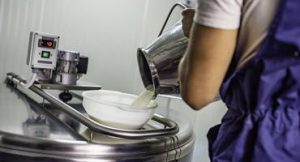
Remember the Y2K doomsday scenario? The computer glitch that was supposed to send civilization back to the Stone Age?
Marcia St. John does.
“I thought Y2K was going to be the end of the world,” she said.
So she prepared.
She spent months learning about self-sufficiency, gardening, herbal medicine, beekeeping and tree grafting. She even defied Seattle city code and smuggled some goats into her Ballard back yard.
“Then, the world didn’t end,” she said. “But I laugh. My world ended.”
Thanks to Y2K, she discovered a new passion: goat farming.
“I was smitten with the goats,” she said. “They are the most joyful creatures on the planet. It’s hard to be in a bad mood when you’re around the goats.”
St. John left her career in the city and moved to a 3-acre farm in Issaquah with her husband. When he died in 2001, when she was 40, caring for the goats helped her work through her grief.
She remarried in 2002 and moved to a farm in the Lake Stevens area, where the herd grew to about 36 animals. Although the marriage eventually ended, St. John remained in Lake Stevens until 2017.
St. John and her goats moved three more times before finally settling on a farm on Pioneer Highway near Stanwood in December.
Her herd has now grown to 165 oberhasli goats, a Swiss breed whose milk she sums up in one word: “Incredible.”
Her farm, St. John Creamery, produces unpasteurized milk and cheeses such as cheddar, gouda and feta.
The milk from the creamery is delivered to co-ops from Bellingham to Tacoma. Cheese sales, which had stalled due to her moves, resumed in August, available at local farmers markets and co-ops.
Her goats’ milk is collected in three-gallon stainless steel buckets and taken to the creamery, where it is double-filtered. The milk is bottled, labeled, sold and delivered to customers. What’s left over is kept for cheeses.
All told, it takes about 38 gallons of milk to produce 27 pounds of cheese. About three batches are made each week when the goats are in production. They stop producing milk when they are pregnant.
Although farmers with dairy cows might argue the point, St. John said cheese made from goat milk has more complex flavors — “almost like a symphony” — with nuances that aren’t there in cheese made from cow’s milk.
St. John, now 58, has been running a goat dairy for 11 years, assisted by interns who come from around the country to study raw goat milk production.
One of the favorite parts of her day is when she calls out “C’mon, girls!” — the call to put her animals out to pasture. “They come kicking and spinning, they’re so excited,” she said.
“Goats are silly and inquisitive and love to dance. Anything they’re excited about, they jump and spin and make you laugh.”
Sheep cheese
The hilly pastures near Clinton on Whidbey Island provide premium grazing area for the 80 milking ewes on the Glendale Shepherd farm.
“They do well on the slopes; it’s good drainage for their feet,” said Lynn Swanson, who runs the sheep farm with her husband, Stan, and grown son, Erik.
The herd, a mixture of European and American breeds, produce as many as seven cheeses, available at farmers markets in Langley and Seattle.
But even with photos of the farm’s animals before them, sometimes farmers market customers confuse what’s being sold, asking: “What kind of goat cheese is that?”
“Many people say ‘I didn’t know you could milk a sheep,’” Lynn Swanson said.
Although dairy sheep are relatively rare in the United States, they are widespread in Greece, France, Europe and the Middle East. “Some of the most famous cheeses in the world are made from sheep milk,” Swanson said.
The Swansons have been producing cheese and yogurt from sheep milk since 2011, when the farm was granted a Grade A dairy license.
Of their seven varieties of cheeses — some pasteurized and some raw — the most popular is Island Brebis, aged for up to a year. “It sells out faster than we can keep up,” she said.
The cheese types available at any one time come and go because the sheep produce milk for only about six months of the year. By splitting the flocks into three bands, she hopes eventually to produce cheese year-round.
Splitting the herd spreads out the lambing season to three times a year, with births of about 40 to 50 lambs rather than 150 all at once.
Regardless of the size of the lambing season, preparations make for a busy schedule of cleaning barns, moving sheep and preparing for the newborns. The lambs are kept in a special barn so they can nurse around the clock.
“It’s my favorite part of the year, for sure,” Lynn Swanson said. “There’s nothing like seeing those lambs being born and being beautiful and healthy. That is just the biggest, most rewarding part of it.”
Photos from their “lamb cams” of pregnant ewes are sometimes posted on the farm’s Facebook page.
The family business began with Erik Swanson’s interest in organic farming. The family had a band of sheep and began milking them. Lynn Swanson began experimenting with making cheese in her kitchen.
Although she experienced what she candidly describes as some spectacular failures, she said she was surprised at how good many of the cheeses turned out. She took classes and workshops in cheese making to refine her skills. Meanwhile, Erik Swanson visited sheep dairies to learn the business.
In addition to making several varieties of cheeses, the farm now produces an average of 30 gallons per week of yogurt — an estimated 1,400 gallons per year.
The family’s work has earned it a growing supply of regular customers, as well as national recognition. In 2014, its Island Brebis cheese was selected for a national Good Food Award, which recognizes environmental responsibility, craftsmanship and flavor.
“The milk is excellent and just makes great cheese,” Lynn Swanson said. “I don’t think you could have that kind of control over your product if you weren’t milking them yourself.”
Washington cheese
Since the early 2000s, Washington’s artisan cheese industry has grown to 58 licensed cheese makers. They range from large producers, such as Beecher’s Handmade Cheese, to small-scale independents that sell out of their own shops or farmers markets, said Lindsay Slevin, president of the Washington State Cheesemakers Association.
The cheeses they produce are made from
cow, sheep and goat milk, produced in fresh and aged styles, made from raw and pasteurized milk.
Despite the growth in artisan cheese making, Slevin said there’s still room for those who wish to pursue the art. But those who do want to start producing cheese need to know it’s a tough industry to get into, with high regulation and expenses, she said.
“You don’t just turn a key and start making cheese,” she said.

























